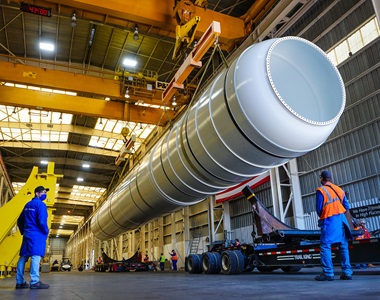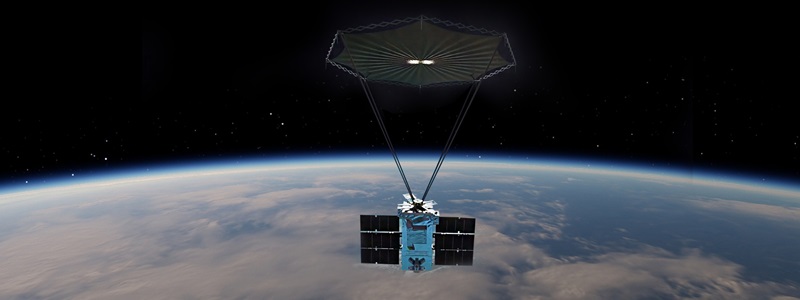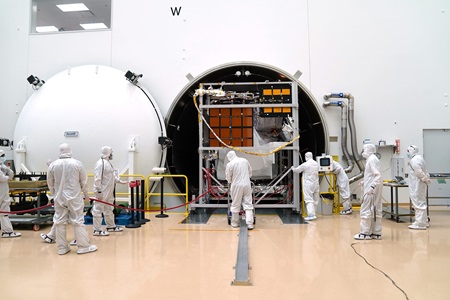Satellite Services in Space

By Albert McKeon
Imagine dark TV screens, radio stations without sound and weather reports lacking information. Such would be life without satellite services.
Fortunately, a special type of satellite perseveres, consistently relaying and amplifying telecommunications signals that power television, radio, weather and military applications. But eventually, these Geostationary Equatorial Orbit (GEO) satellites after about 15 years, need more fuel.
Of course, fueling and repairing a satellite in space isn't like driving a car to the nearest service station. But Northrop Grumman engineers have thought of the next best thing: bringing the service station to the satellites.
With three unique inventions — a Mission Extension Vehicle, Mission Robotics Vehicle and Mission Extension Pods — Northrop Grumman gives telecommunications companies, militaries and other organizations a chance to prolong the lives and usefulness of their expensive space technology. A GEO satellite provides immense value from its perch in high orbit, but it is very expensive to build and launch one into space.
By lengthening the functionality of the satellites with cost-effective and safe methods that are both innovative and grounded in time-tested practices, the three mission extension technologies herald a market transformation — according to Joseph Anderson, the vice president of Business Development and Operations at Space Logistics LLC (a wholly owned subsidiary of Northrop Grumman). He believes the prevailing wisdom should no longer be that once a satellite has run out of fuel, it's time to shut down the program.

A Restorative Rendesvouz in Space
About 22,200 miles from the Earth’s surface, the orbital speed of satellites can keep up with the rotational speed of the planet below, making it appear as if the spacecraft are not moving at all when they actually are.
"They still require fuel in that orbit," Anderson said. "There is gravity and disturbance forces as they continuously move around."
Indeed, as with all mechanical objects that operate in space, the satellites contend with wear and tear. After several years of development, and drawing on previous Northrop Grumman spacecraft heritage, the Mission Extension Vehicle (MEV) was developed as a way to reach the GEO satellites and give them longer shelf life.
"We stuck to one important strategy: Keep it simple by building off as much heritage technology as possible," Anderson said.
Indeed, the MEV takes a page out of the book written by NASA’s Gemini space program of the 1960s. Using a cone to capture docking technique, employed by Gemini, the MEV inserts a probe into the liquid apogee engine on the aft end of a satellite. About 80% of satellites have this feature, Anderson said, enabling the MEV to work with a wide array of satellites. The liquid apogee engine guides the probe, which slowly moves through the throat of the engine and captures the satellite. The probe then retracts pulling stanchions against the ring to lock together the crafts.
Anderson has seen the "keep it simple" strategy pay off twice, as two separate MEVs have now successfully attached to GEO satellites and halted impending decommissioning. First, an MEV docked with Intelsat satellite IS-901 in early 2020 and corrected its orbit. MEV-1, a name to commemorate the first mission, will give IS-901 an additional five years of service, helping the satellite continue to point toward its targeted antennas on Earth.
On the second such mission, MEV-2 joined with another Intelsat satellite, IS-10-02, in spring 2021, also with the aim of extending service by five years. The MEVs act as additional engines with more fuel. They can assist with maneuvering and pointing control for as long as 15 years. And the MEVs aren't limited to singular missions; they can later support other satellites.
"If customers can extend the life of a satellite by even five years, it has significant impact," Anderson said. "They can delay spending up to $500 million for a new satellite. It's an interesting business model."

Satellite Assistance at Your Service
The MEV program is the start of a new paradigm, Anderson said. Northrop Grumman is developing two other technologies to provide more satellite services in geostationary orbit: the Mission Robotic Vehicle (MRV) and the Mission Extension Pods (MEP).
The MRV is expected to launch in the next few years. With two long-reaching robotic arms created by DARPA, the MRV will inspect, repair and augment satellites. It will also install a MEP onto a client satellite.
The MEP is kind of a mini version of the MEV. It provides additional propulsion, but unlike the MEV, it cannot point the client vehicle towards the earth— instead only supporting its positioning in space. An MEP will give the gift of about six years of additional service.
Development of these new satellite services wasn't just about engineering. The project called for Northrop Grumman to work with the U.S. government to develop a means for licensing these new types of missions and capabilities. Until now, the government licensed only communications and earth observation satellites, Anderson said. He and his colleagues also worked with the space insurance market to develop a means to properly insure this new kind of spacecraft. Insurers previously had covered communications satellites and imaging satellites, but nothing like this, he noted.

Plans for Future Space Logistic Technology
If servicing satellites in space seems like a big leap, Northrop Grumman intends to make even bigger jumps in the future. In the latter half of this decade, it plans to deploy mission refueling pods — traveling gas pumps, so to speak — as well as the depots that store the fuel into geostationary orbit.
The 562 GEO satellites that are now active will eventually need a place to rest when decommissioned; they will probably join others already parked in a "geo graveyard" nearly 200 miles away from the busy geo orbit. Still, pieces of satellites inevitably come loose during their commissioned lifespan and can pose a problem to other satellites. To clear those travel lanes, Northrop Grumman is creating technology that will remove debris from active GEO orbit.
Perhaps the most exciting new project, albeit one that's at least a decade away from realization, is the building of satellites in space.
"Eighty percent of the mass of a satellite is just to support a launch," Anderson said. "Imagine what would happen if we could assemble satellites in orbit?" The plan is still in its early stages, but Anderson envisions robots creating satellites with 3D printers, requiring less material to be launched.
"Rather than throw away satellites," he said, "we can make them reusable."


